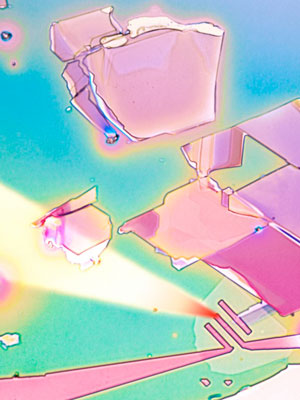| Jan 24, 2019 | |
Breakthrough reported in fabricating nanochips(Nanowerk News) An international team of researchers has reported a breakthrough in fabricating atom-thin processors - a discovery that could have far-reaching impacts on nanoscale chip production and in labs across the globe where scientists are exploring 2D materials for ever-smaller and -faster semiconductors. |
|
| The team, headed by New York University Tandon School of Engineering Professor of Chemical and Biomolecular Engineering Elisa Riedo, outlined the research results in the latest issue of Nature Electronics ("Patterning metal contacts on monolayer MoS2 with vanishing Schottky barriers using thermal nanolithography"). | |
 |
|
| This is an image of a one-atom-deep layer of molybdenum disulfide with electrodes patterned by hot nano-tip in a new process called thermal scanning probe lithography. Researchers at NYU Tandon School of Engineering invented the process to produce high-quality semiconductors at a cost significantly lower than current electron beam lithography. (Image: NYU Tandon) | |
| They demonstrated that lithography using a probe heated above 100 degrees Celsius outperformed standard methods for fabricating metal electrodes on 2D semiconductors such as molybdenum disulfide (MoS2). Such transitional metals are among the materials that scientists believe may supplant silicon for atomically small chips. The team's new fabrication method - called thermal scanning probe lithography (t-SPL) - offers a number of advantages over today's electron beam lithography (EBL). | |
| First, thermal lithography significantly improves the quality of the 2D transistors, offsetting the Schottky barrier, which hampers the flow of electrons at the intersection of metal and the 2D substrate. Also, unlike EBL, the thermal lithography allows chip designers to easily image the 2D semiconductor and then pattern the electrodes where desired. | |
| Also, t-SPL fabrication systems promise significant initial savings as well as operational costs: They dramatically reduce power consumption by operating in ambient conditions, eliminating the need to produce high-energy electrons and to generate an ultra-high vacuum. Finally, this thermal fabrication method can be easily scaled up for industrial production by using parallel thermal probes. | |
| Riedo expressed hope that t-SPL will take most fabrication out of scarce clean rooms - where researchers must compete for time with the expensive equipment - and into individual laboratories, where they might rapidly advance materials science and chip design. The precedent of 3D printers is an apt analogy: Someday these t-SPL tools with sub-10 nanometer resolution, running on standard 120-volt power in ambient conditions, could become similarly ubiquitous in research labs like hers. |
| Source: NYU Tandon School of Engineering | |
|
Subscribe to a free copy of one of our daily Nanowerk Newsletter Email Digests with a compilation of all of the day's news. |
